Optimal Dispatch Model Considering Environmental Cost Based on Combined Heat and Power with Thermal Energy Storage and Demand Response
Abstract
1. Introduction
- We analyze the operation characteristics of CHP with TES and incentive-based DR, respectively. Then, the cost formula of incentive-based DR participating in power grid dispatching is given.
- An economic power dispatch model based on CHP-DR is proposed. In this dispatch model, the emission cost of CO2, SO2, NOx, the operation cost of desulfurization units, and the operation cost of denitrification units are considered as environmental cost, which increases the cost of power generation.
- Two dispatch models are set and the data in one week is utilized to verify the effectiveness. One dispatch model takes the environmental cost into account and the other does not. The results show that the daily average emissions of CO2, SO2, and NOx are decreased by 14,354.35 kg, 55.5 kg, and 47.15 kg, respectively, and the wind power accommodation is increased by an average of 6.56%.
2. Operating Characteristic and Dispatch Model of CHP with TES and DR
2.1. Operation Characteristic and Modeling of CHP with TES
2.2. Incentive-Based DR
3. Dispatch Model
3.1. Objective Function
3.2. Constraints
4. Analysis of Examples
4.1. The Setup of Simulation
- Firstly, we confirm that the optimization variables are , , , , Pi,t, , and . The objective of optimization is to minimize the total dispatching cost.
- Secondly, the values of the parameters in Table 1 and the environmental cost parameters are substituted into Equations (1), (10), (13), (15), (18), (20), and (23). Then, these formulas are summed as the objective function.
- Finally, the constraints (5)–(9), (11), (12), (25)–(30) are entered in the GUI interface of the GA-Toolbox in MATLAB 2018a (MathWorks, Natick, MA, USA), so that the solution process is within a reasonable range.
4.2. Comparison of Different Dispatch Models
4.3. Analysis of Dispatch Results of One Day
5. Conclusions
Author Contributions
Funding
Acknowledgments
Conflicts of Interest
Nomenclature
| CHP | Combined heat and power |
| TES | Thermal energy storage |
| DR | Demand response |
| EES | Electric energy storage |
| SOC | State of charge |
| GA | Genetic Algorithm |
| FCT | Total cost of CHP with TES |
| N/M/n/m | Number of CHP/TES/thermal power units/EES |
| T | The number of hours in operation |
| Cc,i | Fuel cost of CHP i with TES |
| FTC,j | Average daily investment cost of TES j |
| FTW,j | Operation and maintenance cost of TES j |
| am/bm/cm | Operation cost coefficients of CHP with TES |
| Electrical power of CHP i at time t | |
| Thermal power of CHP i at time t | |
| / | Lower/upper limits of electrical power for CHP i |
| / | Lower/upper limits of thermal power for CHP i |
| / | Lower/upper ramp rate limits of CHP i |
| cv | The linear supply slopes of thermal power and electric power of CHP |
| Thermal power of TES j at time t | |
| / | Rated power/capacity of TES j |
| CTP/CTE | Power/capacity cost coefficients of TES |
| TT,j | Service life of TES j |
| CU | Operation and maintenance cost coefficient of TES |
| Sj,t | Capacity of TES j at time t |
| Smin,j/Smax,j | Lower/upper capacity limits of TES j |
| / | Lower/upper thermal power limits of TES j |
| FDR | Total incentive cost of DR |
| ρ | The incentive cost coefficient |
| The value of dispatch load at time t | |
| Δt | Dispatch time interval |
| PLoad,t/PHeat,t | Electrical load demand/thermal load demand at time t |
| ζLmin/ζLmax | Lower/upper values of load regulation rate |
| / | Lower/upper limited proportions of adjustment of thermal power demand |
| F1 | Fuel cost of thermal power units |
| Ch,i | Fuel cost of thermal power unit i |
| ai/bi/ci | The cost coefficients of thermal power unit i |
| Pi,t | Power of thermal power unit i at time t |
| Pmin,i/Pmax,i | Lower/upper power generation limits of thermal power unit i |
| rd,i/ru,i | Lower/upper ramp rate limits of thermal power unit i |
| F2 | Total cost of EES |
| FEC,i/FEW,i | Average daily investment cost/the operation and maintenance cost of EES i |
| CEP/CEE | Power/capacity cost coefficients of EES |
| / | Rated power/capacity of EES i |
| Power of EES i at time t | |
| TE,i | Service life of EES i |
| CO | Operation and maintenance cost coefficient of EES |
| SOCmin,i/SOCmax,i | Lower/upper SOC limits of EES i |
| / | Lower/upper power limits of unit i |
| F3 | Carbon cost |
| CCP/CSP/CNP | Environmental cost coefficient of CO2/SO2/NOx |
| WC/WS/WN | Emission of CO2/SO2/NOx |
| δC/δS/δN | Emission of CO2/SO2/NOx by a unit mass of coal combustion |
| βm | Unit-price of coal |
| F4 | Operation cost of desulfurization and denitrification equipment and the emission cost of SO2 and NOx |
| CS/CN | Operation cost of desulfurization and denitrification device to remove unit mass of SO2/NOx |
| η | Efficiency of desulfurization and denitrification device |
| F5 | Cost of wind curtailment |
| CQ | Unit-cost of wind curtailment |
| Wind curtailment at time t |
References
- Liu, D.; Zhang, G.; Huang, B.; Liu, W. Optimum Electric Boiler Capacity Configuration in a Regional Power Grid for a Wind Power Accommodation Scenario. Energies 2016, 9, 144. [Google Scholar] [CrossRef]
- Yang, L.J.; Zhang, X.; Gao, P. Research on Heat and Electricity Coordinated Dispatch Model for Better Integration of Wind Power Based on Electric Boiler with Thermal Storage. IET Gener. Transm. Distrib. 2018, 12, 3736–3743. [Google Scholar] [CrossRef]
- Shao, C.Z.; Ding, Y.; Wang, J.H.; Song, Y.H. Modeling and Integration of Flexible Demand in Heat and Electricity Integrated Energy System. IEEE Trans. Sustain. Energy 2018, 45, 361–370. [Google Scholar] [CrossRef]
- Lei, S.B.; Hou, Y.H.; Wang, X.; Liu, K. Unit Commitment Incorporating Spatial Distribution Control of Air Pollutant Dispersion. IEEE Trans. Ind. Inform. 2017, 13, 995–1005. [Google Scholar] [CrossRef]
- Wang, X.; Li, H. Multi-Objectives Combined Electric Heating Dispatch Model of Wind Power Accommodation with Heat Storage Device. IET J. Eng. 2017, 13, 1539–1545. [Google Scholar] [CrossRef]
- Lorestani, A.; Ardehali, M.M. Optimization of Autonomous Combined heat and Power System Including PVT, WT, Storages, and Electric Heat Utilizing Novel Evolutionary Particle Swarm Optimization Algorithm. Renew. Energy 2018, 119, 490–503. [Google Scholar] [CrossRef]
- Ma, H.; Chen, Q.; Hu, K.; Dai, Y.H.; Chen, L.; Xu, F. A Dispatch Method of Combined Heat and Power Plants with Heat Storage Facilities for Wind Power Accommodation. In Proceedings of the IEEE, International Conference on Renewable Energy Research and Applications, San Diego, CA, USA, 5–8 November 2017; pp. 262–272. [Google Scholar]
- Chen, H.H.; Zhang, R.F.; Li, G.Q.; Bai, L.Q.; Li, F.X. Economic Dispatch of Wind Integrated Power Systems with Energy Storage Considering Composite Operating Costs. IET Gener. Transm. Distrib. 2016, 10, 1294–1303. [Google Scholar] [CrossRef]
- Dai, Y.H.; Chen, L.; Min, Y.; Chen, Q.; Hu, K.; Hao, J.H. Dispatch Model of Combined Heat and Power Plant Considering Heat Transfer Process. IEEE Trans. Sustain. Energy 2017, 8, 1225–1236. [Google Scholar] [CrossRef]
- Han, L.; Zhang, R.; Wang, X.; Dong, Y. Multi-Time Scale Rolling Economic Dispatch for Wind/Storage Power System Based on Forecast Error Feature Extraction. Energies 2018, 11, 2124. [Google Scholar] [CrossRef]
- Dai, Y.H.; Chen, L.; Min, Y.; Mancarella, P.; Chen, Q.; Hu, K.; Hao, J.H. A General Model for Thermal Energy Storage in Combined Heat and Power Dispatch Considering Heat Transfer Constraints. IEEE Trans. Sustain. Energy 2018, 9, 1518–1528. [Google Scholar] [CrossRef]
- Li, Z.G.; Wu, W.C.; Shahidehpour, M.; Wang, J.G.; Zhang, B.M. Combined Heat and Power Dispatch Considering Pipeline Energy Storage of District Heating Network. IEEE Trans. Sustain. Energy 2016, 7, 12–22. [Google Scholar] [CrossRef]
- Dai, Y.H.; Chen, L.; Min, Y.; Chen, Q.; Hao, J.H.; Hu, K.; Xu, F. Dispatch Model for CHP With Pipeline and Building Thermal Energy Storage Considering Heat Transfer Process. IEEE Trans. Sustain. Energy 2018, 10, 192–203. [Google Scholar] [CrossRef]
- Dai, Y.H.; Chen, L.; Min, Y.; Pierluigi, M.; Chen, Q.; Hao, J.H.; Hu, K.; Xu, F. Integrated Dispatch Model for Combined Heat and Power Plant with Phase-Change Thermal Energy Storage Considering Heat Transfer Process. IEEE Trans. Sustain. Energy 2018, 9, 1234–1243. [Google Scholar] [CrossRef]
- Tariq, S.; Edward, K.; Petr, S. Automated Demand Response for Smart Buildings and Microgrids: The State of the Practice and Research Challenges. Proc. IEEE 2016, 104, 726–744. [Google Scholar]
- Manijeh, A.; Behnam, M.I.; Kazem, Z. Stochastic Scheduling of Renewable and CHP-Based Microgrids. IEEE Trans. Ind. Inform. 2015, 11, 1049–1058. [Google Scholar]
- Wang, Y.; Ai, X.; Tan, Z.F.; Yan, L.; Liu, S.T. Interactive Dispatch Models and Bidding Strategy of Multiple Virtual Power Plants Based on Demand Response and Game Theory. IET Gener. Transm. Distrib. 2016, 7, 510–519. [Google Scholar]
- Wang, F.; Zhou, L.D.; Ren, H.; Liu, X.L.; Miadreza, S.K.; Catalão, J.P.S. Multi-objective Optimization Model of Source-Load-Storage Synergetic Dispatch for Building Energy System Based on TOU Price Demand Response. IEEE Trans. Ind. Appl. 2018, 54, 1017–1028. [Google Scholar] [CrossRef]
- Hamdi, A.; Ehsan, D.; Farid, M. Dynamic Economic Dispatch Problem Integrated with Demand Response (DEDDR) Considering Non-Linear Responsive Load Models. IEEE Trans. Smart Grid 2016, 7, 2586–2595. [Google Scholar]
- Srikanth, R.R.; Lokesh, K.P.; Bijaya, K.P.; Rajesh, K. Investigating the Impact of Load Profile Attributes on Demand Response Exchange. IEEE Trans. Ind. Inform. 2018, 14, 1382–1391. [Google Scholar]
- Yu, M.M.; Hong, S.H.; Ding, Y.M.; Ye, X. An Incentive-Based Demand Response (DR) Model Considering Composited DR Resources. IEEE Trans. Ind. Electron. 2019, 66, 1488–1498. [Google Scholar] [CrossRef]
- Wang, B.B.; Yang, X.C.; Taylor, S.; Yang, S.C. Chance Constrained Unit Commitment Considering Comprehensive Modelling of Demand Response Resources. IET Renew. Power Gener. 2017, 11, 490–500. [Google Scholar] [CrossRef]
- Dinh, H.N.; Tatsuo, N.; Michihiro, K. A Distributed Optimal Power Dispatch Control Approach for Environment-Friendly Power Grids. IEEE Soc. Instrum. Control Eng. Jpn. 2016, 258–263. [Google Scholar]
- Arash, D.; Cui, Y.; Pegah, A.; Vinod, M.V. Minimizing Electricity Cost and Emissions in Optical Data Center Networks. IEEE/OSA J. Opt. Commun. Netw. 2017, 9, 257–274. [Google Scholar]
- Pouya, P.; Farnaz, S.; Behnam, M.I.; Mehdi, A. Reliable Economic Dispatch of Microgrids by Exchange Market Algorithm. In Proceedings of the IEEE Smart Grid Conference, Jeddah, Saudi Arabia, 12–14 December 2017; pp. 1–5. [Google Scholar]
- Olegs, L.; Aivars, C.; Sigurds, J.; Polina, I. Possibility of Thermal Energy Storage System Implementation at CHP Plant. In Proceedings of the IEEE 12th International Conference on the European Energy Market, Lisbon, Portugal, 19–22 May 2015; pp. 1–5. [Google Scholar]
- Shahab, B.; Aras, S. From Demand Response in Smart Grid Toward Integrated Demand Response in Smart Energy Hub. IEEE Trans. Smart Grid 2016, 7, 650–658. [Google Scholar]
- Qin, J.H.; Wan, Y.N.; Yu, X.H.; Li, C.J. Consensus-Based Distributed Coordination between Economic Dispatch and Demand Response. IEEE Trans. Smart Grid 2018, 99, 1. [Google Scholar] [CrossRef]
- Wang, J.X.; Zhong, H.W.; Xia, Q.; Kang, C.Q.; Du, E.S. Optimal Joint-Dispatch of Energy and Reserve for CCHP-Based Microgrids. IET Gener. Transm. Distrib. 2017, 11, 785–794. [Google Scholar] [CrossRef]
- Al-Roomi, A.R.; El-Hawary, M.E. A Novel Multiple Fuels’ Cost Function for Realistic Economic Load Dispatch Needs. In Proceedings of the IEEE Electrical Power and Energy Conference, Saskatoon, SK, Canada, 22–25 October 2017; pp. 1–6. [Google Scholar]
- Yuan, C.C.; Gu, C.H.; Li, F.R.; Bless, K.; Roderick, W.D. New Problem Formulation of Emission Constrained Generation Mix. IEEE Trans. Power Syst. 2013, 28, 4064–4071. [Google Scholar] [CrossRef]
- Ismail, Z.; Farid, B.; Amel, G.; Yacine, S. Combined Economic Emission Dispatch with New Price Penalty Factors. In Proceedings of the 2015 4th International Conference on Electrical Engineering (ICEE), Boumerdes, Algeria, 13–15 December 2015; pp. 1–5. [Google Scholar]
- Ismail, Z.; Farid, B.; Yacine, S.; Amel, G. Combined Dynamic Economic/Emission Dispatch Using Simulated Annealing Solution. In Proceedings of the 2015 4th International Conference on Systems and Control (ICSC), Sousse, Tunisia, 28–30 April 2015; pp. 302–309. [Google Scholar]
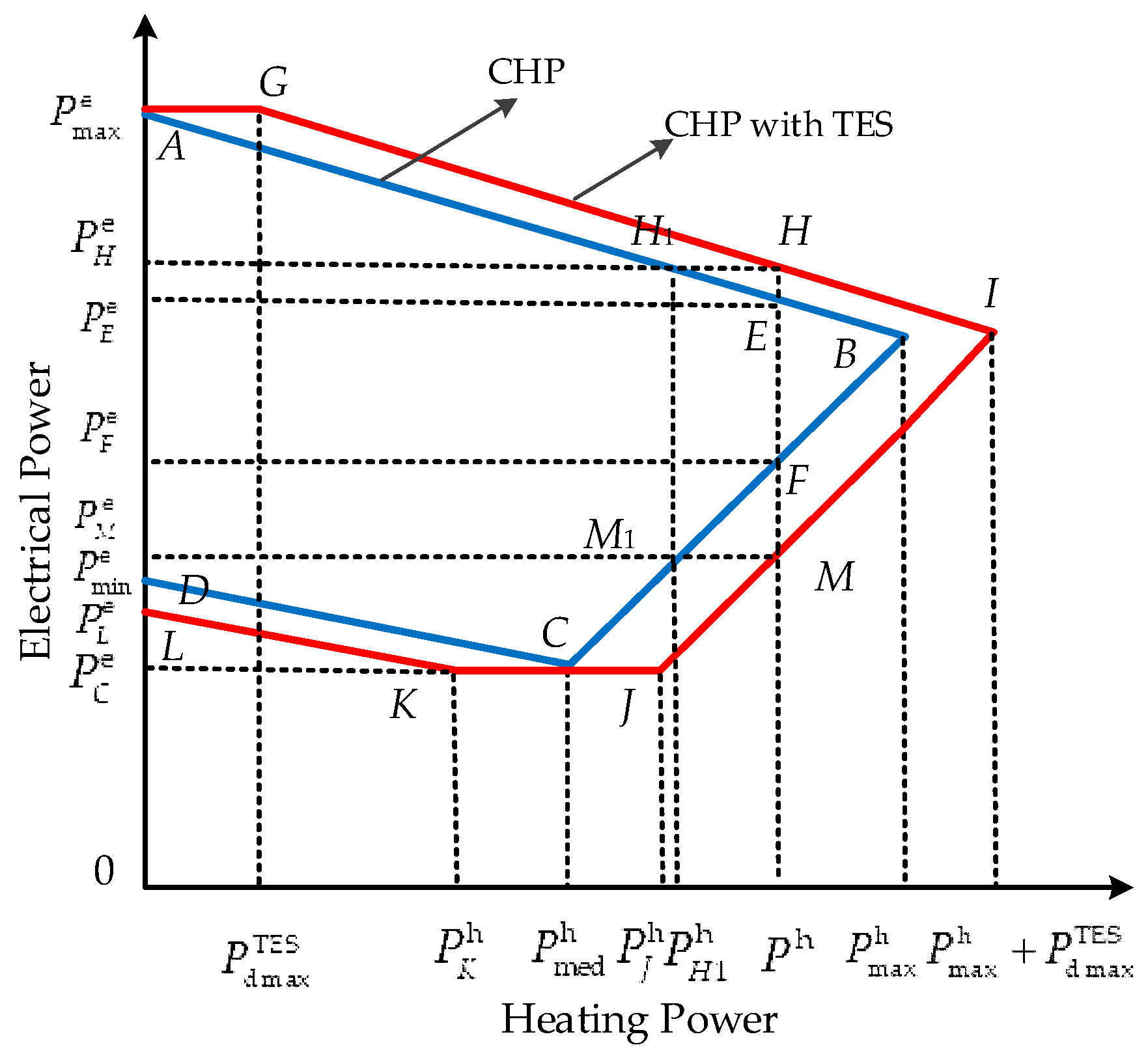
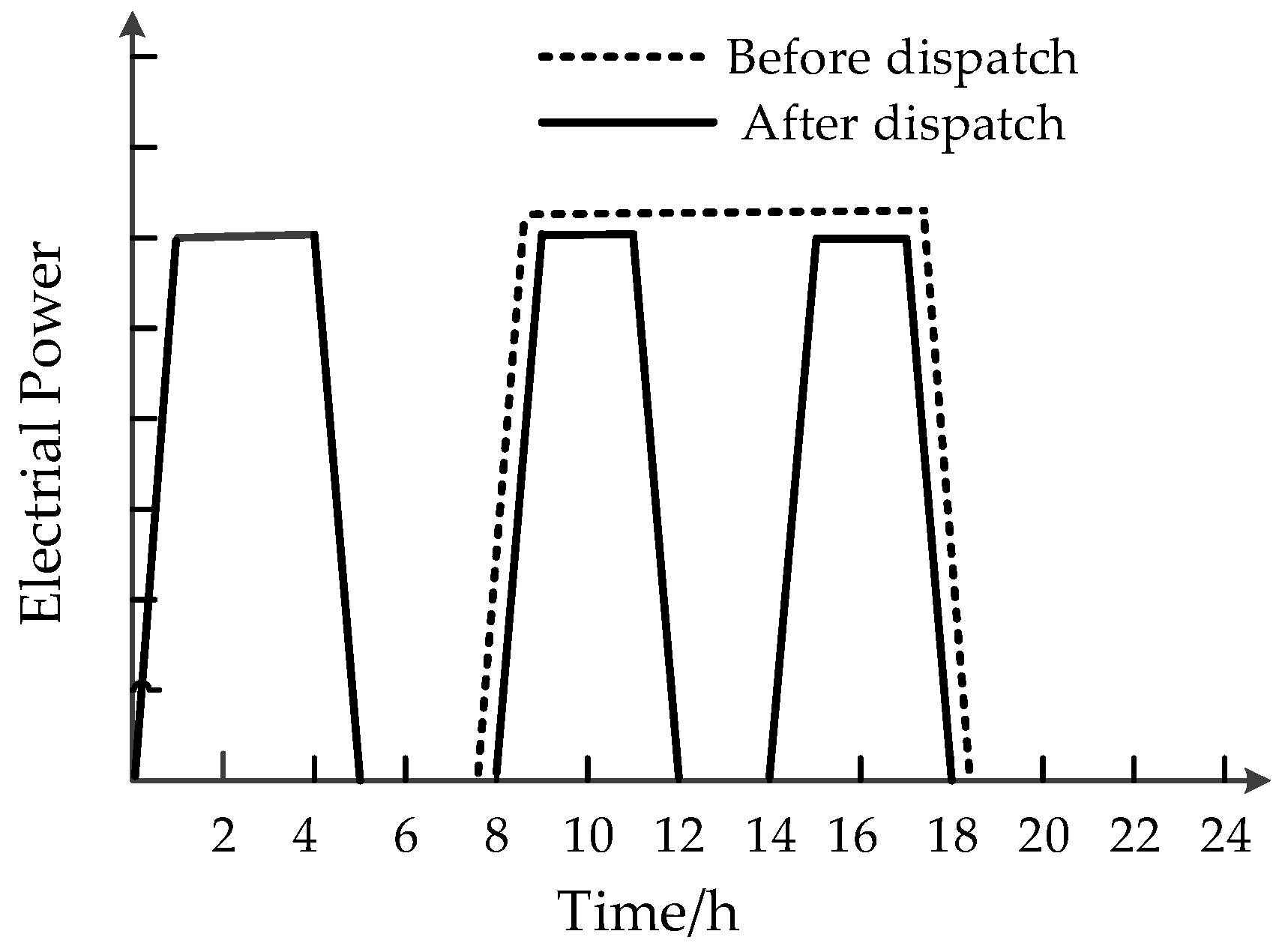
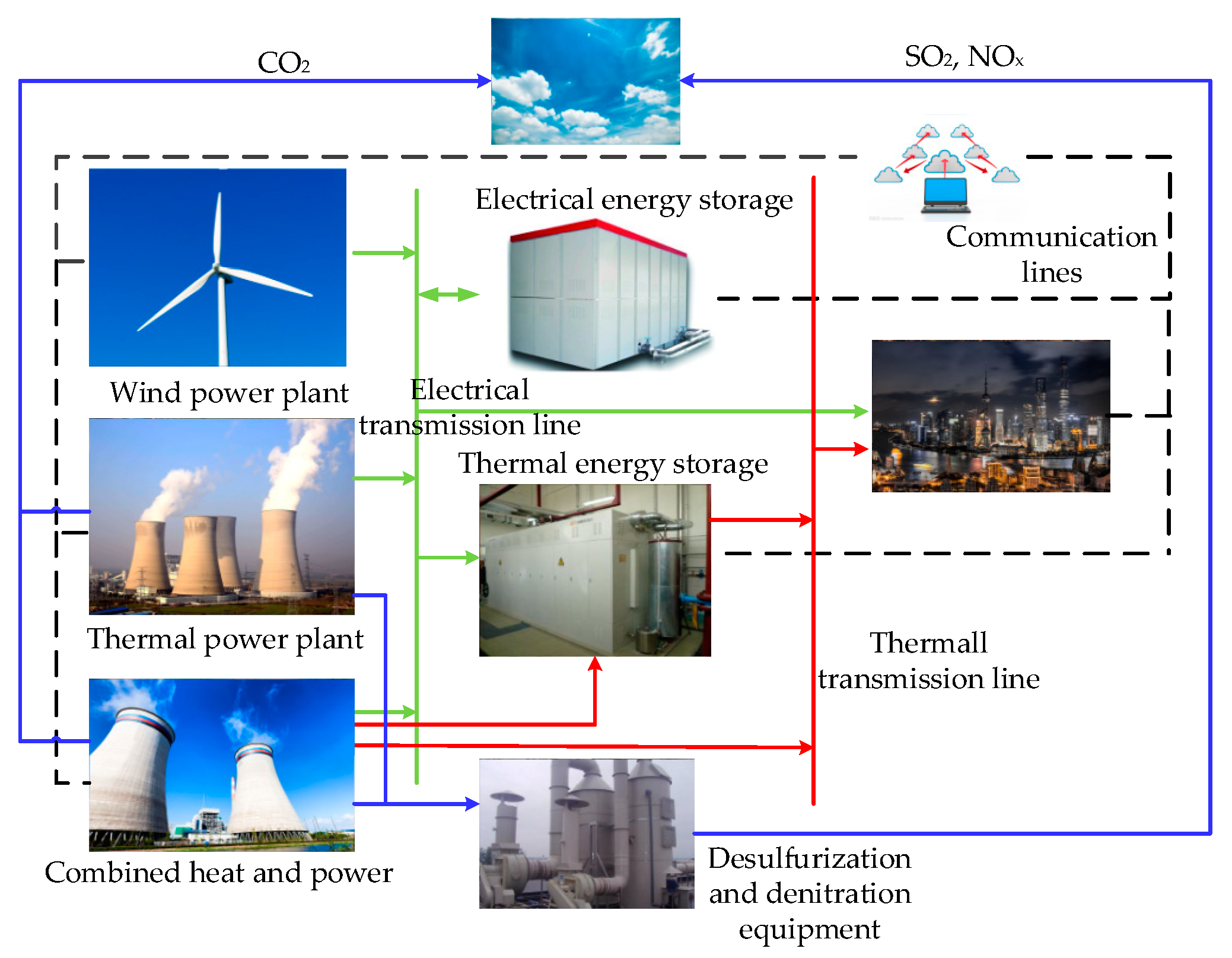
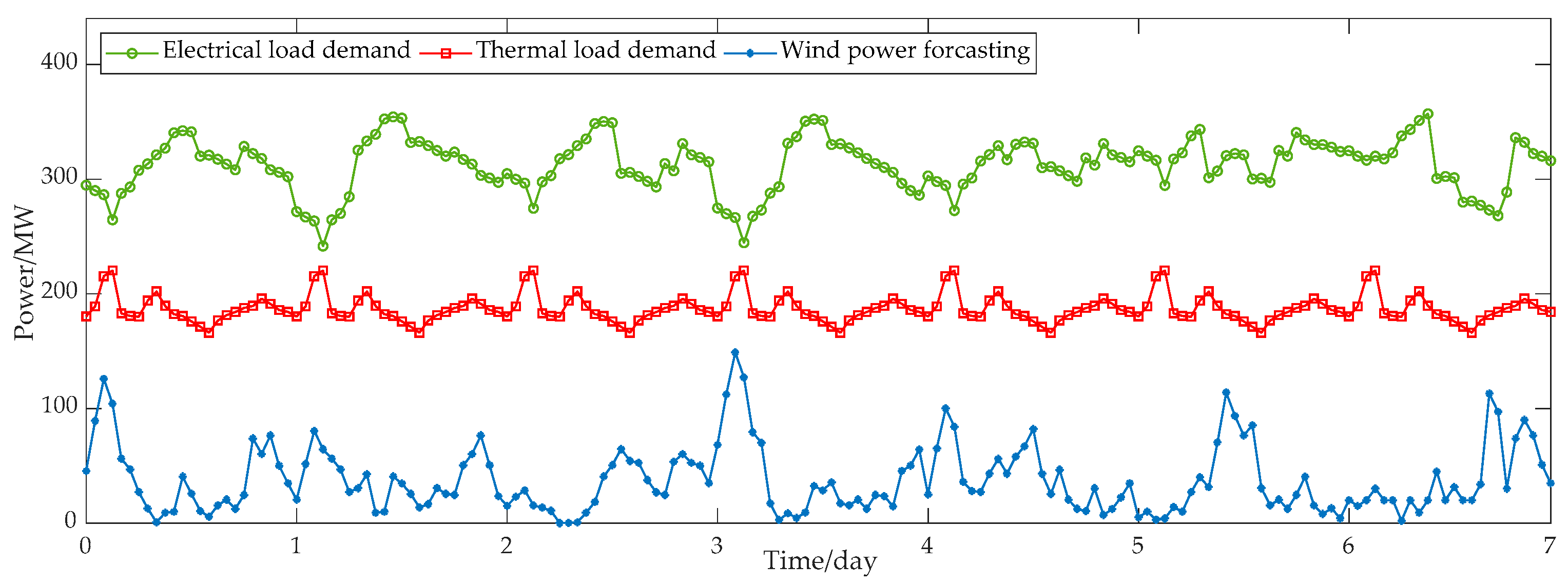
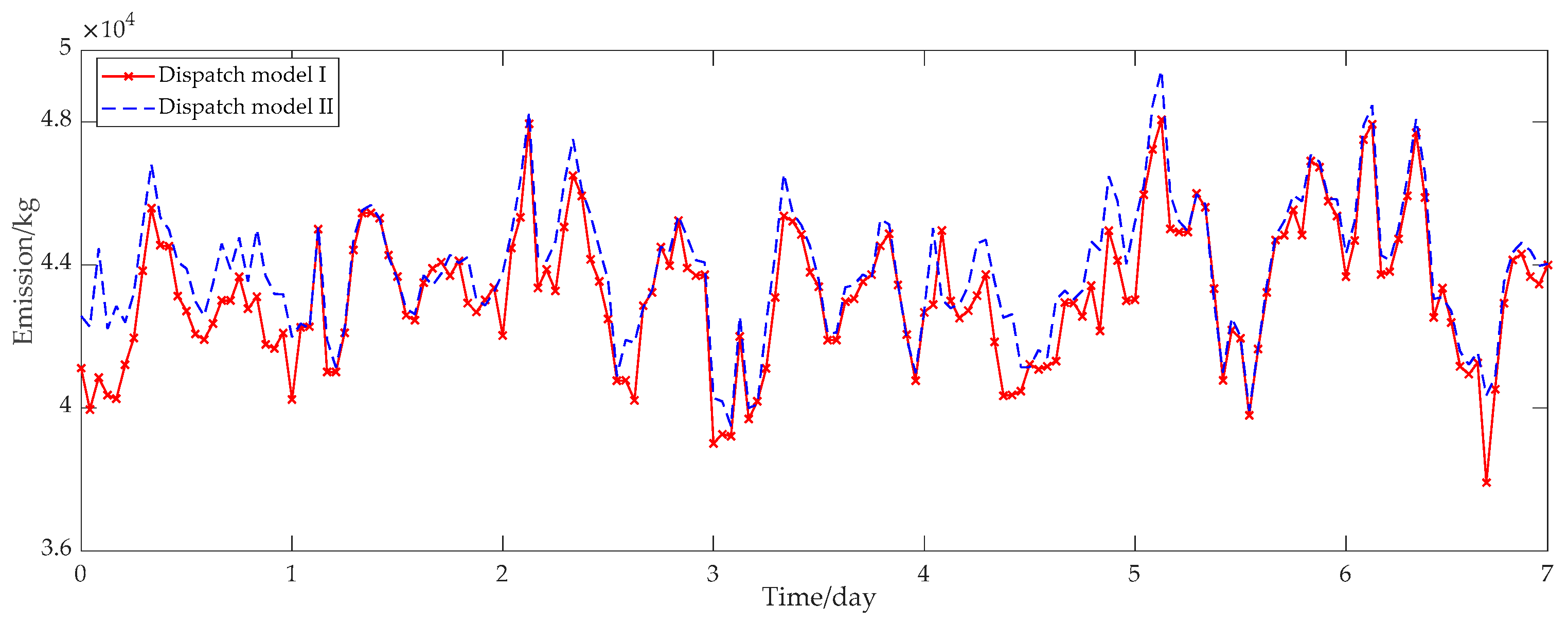
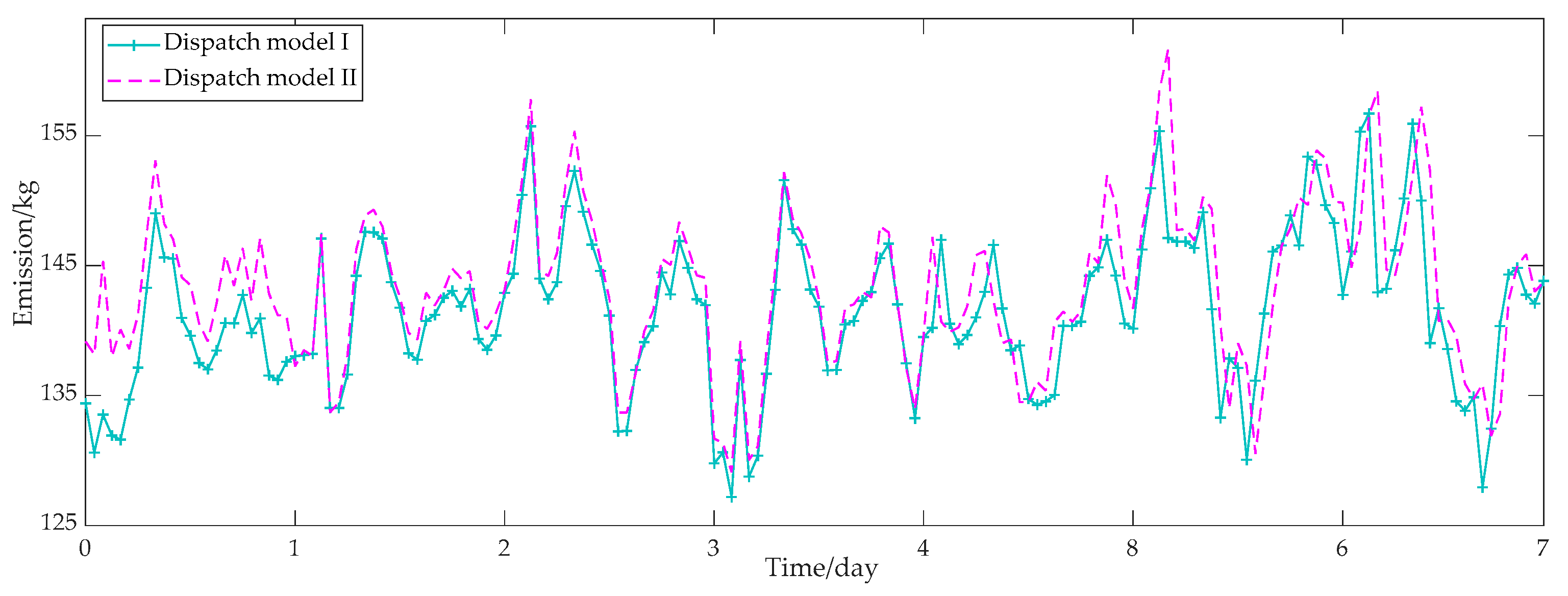
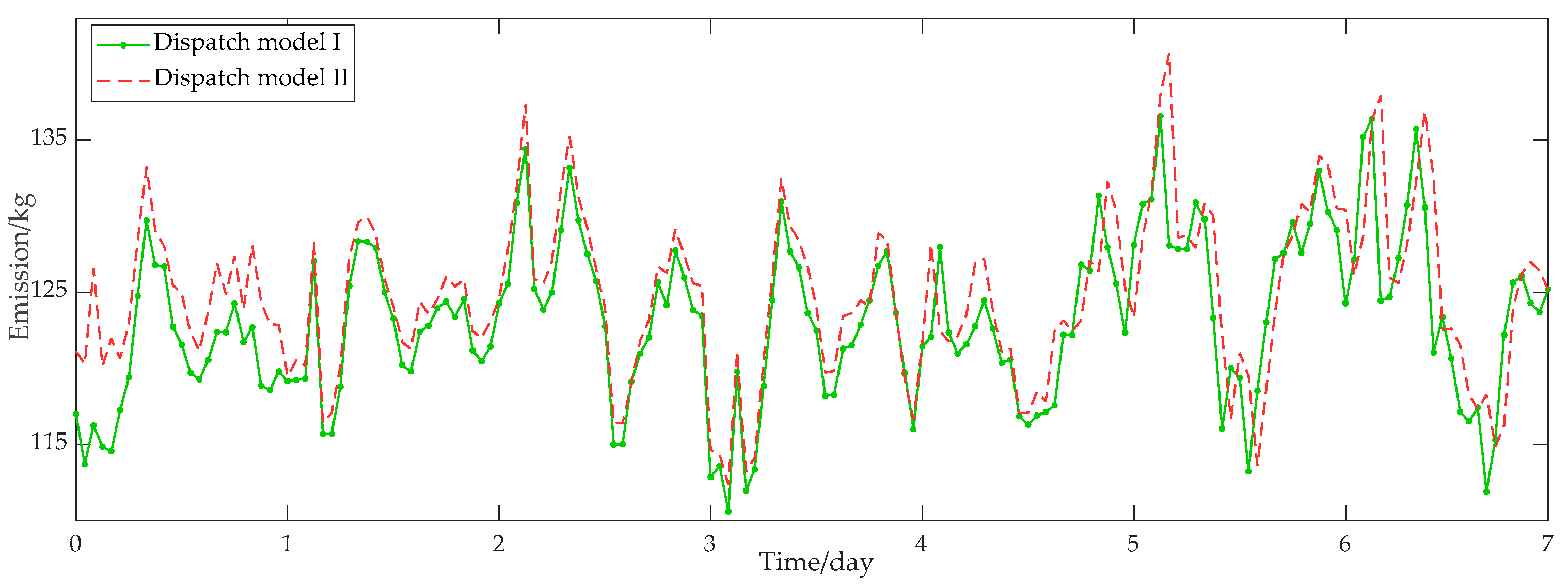
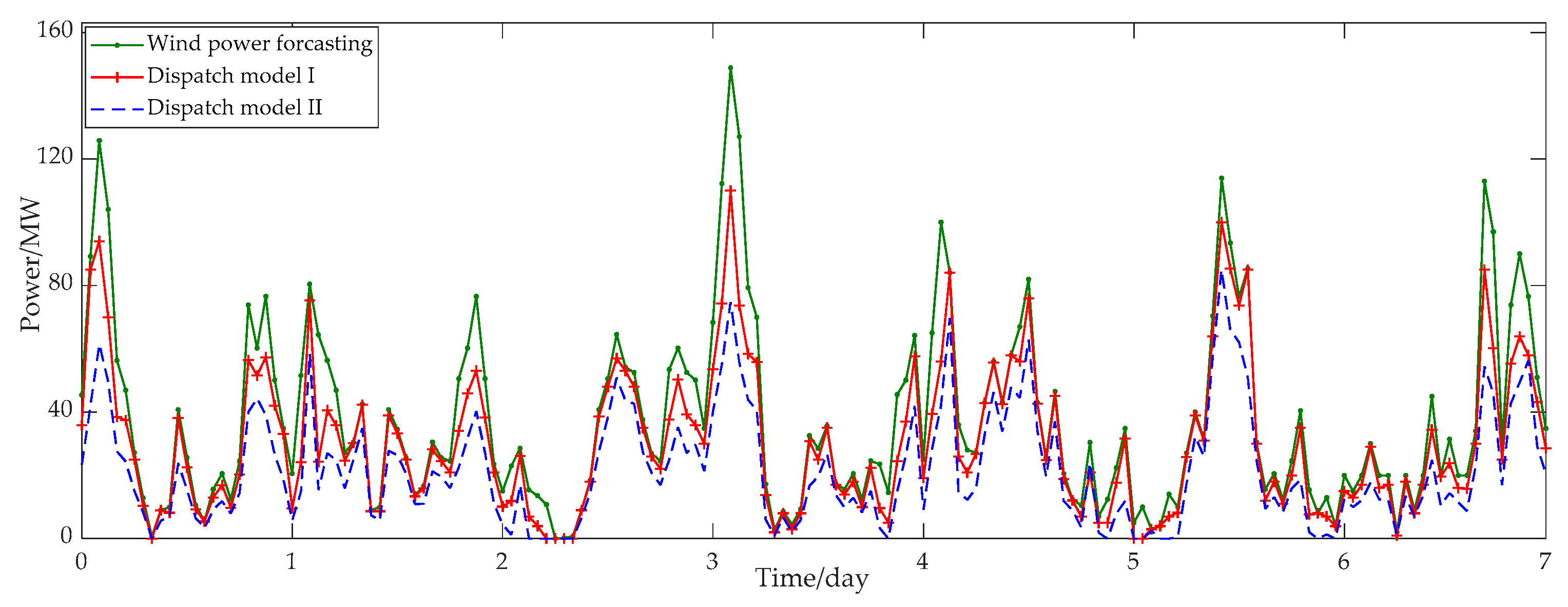
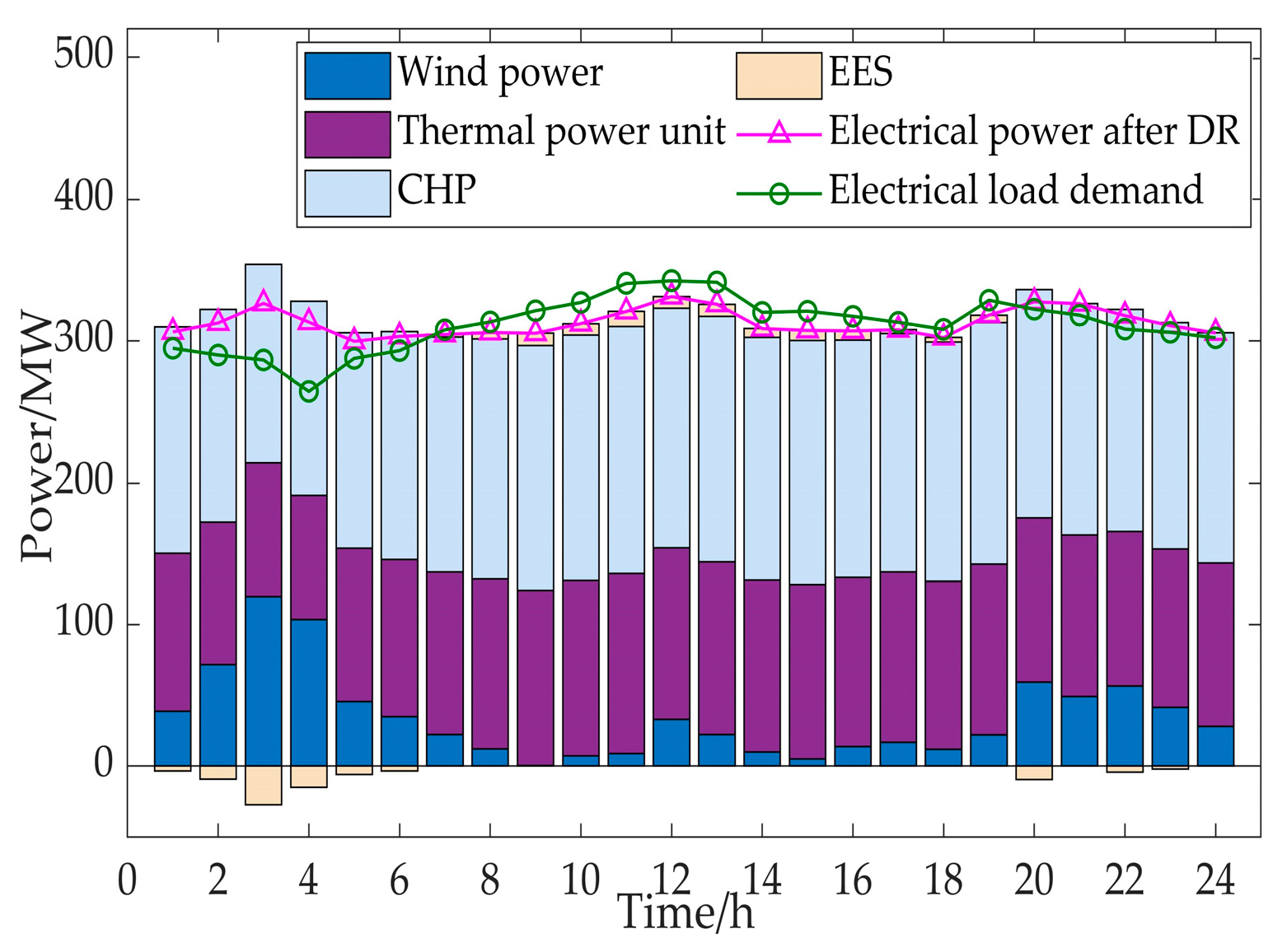

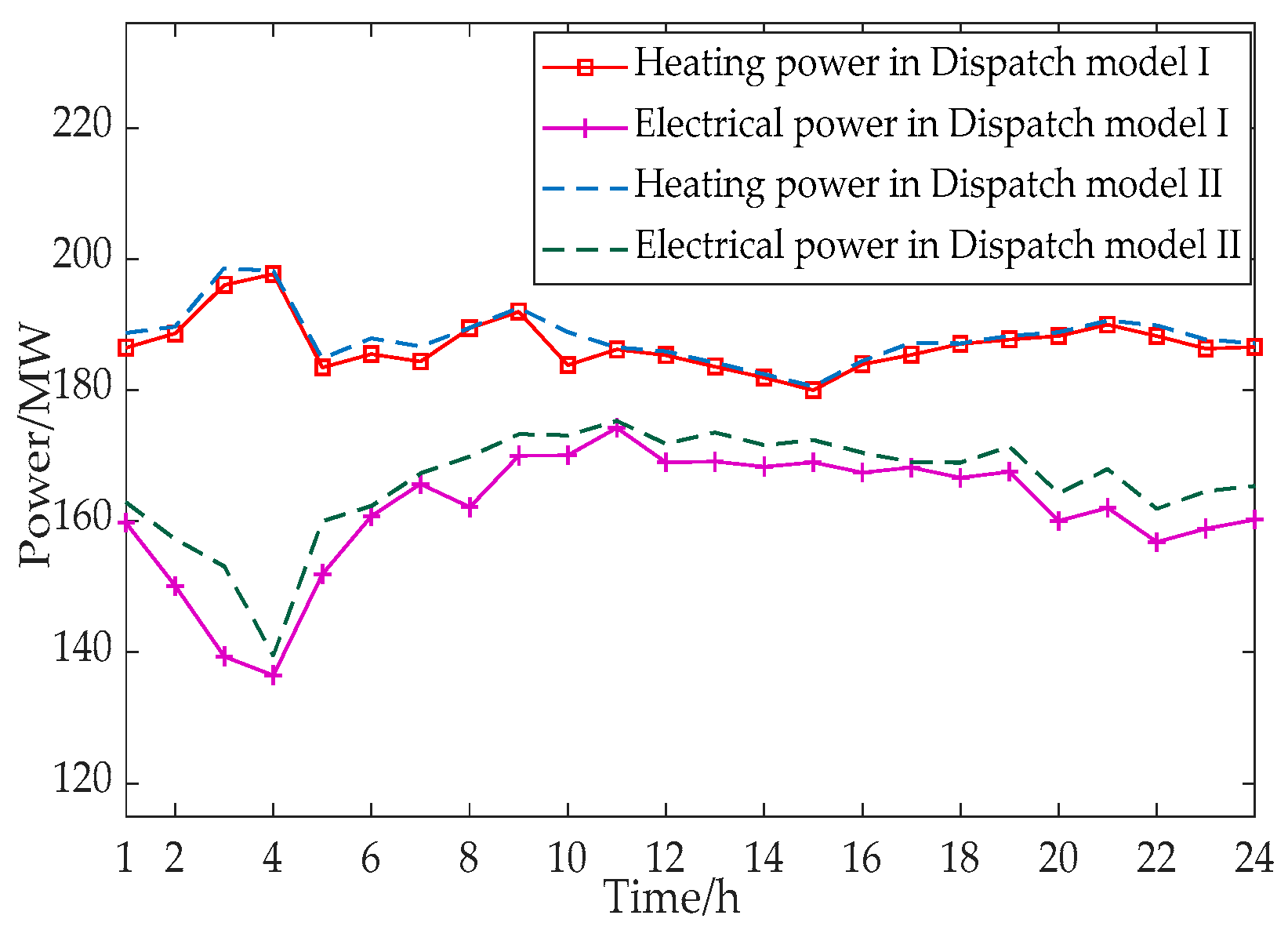

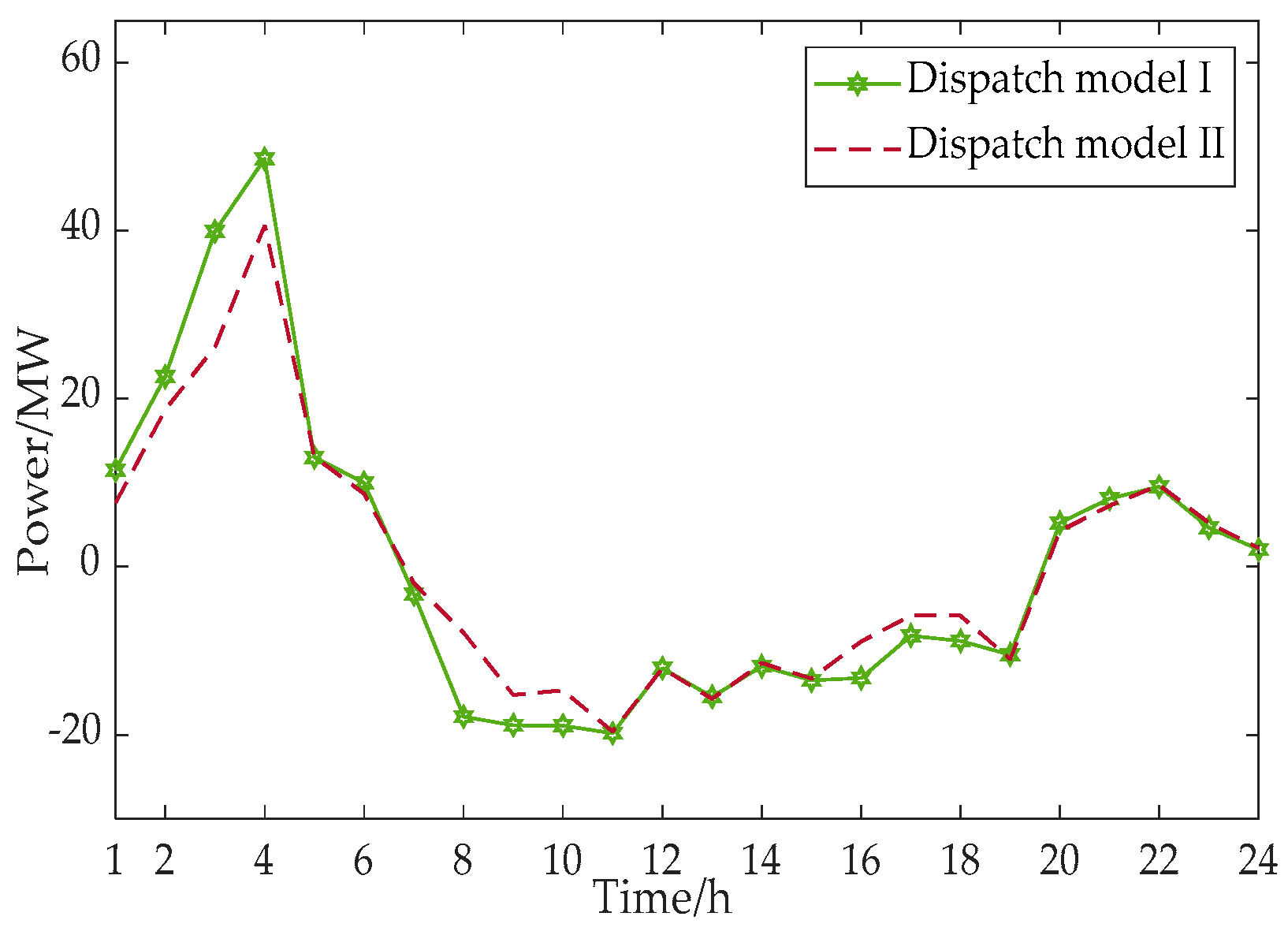
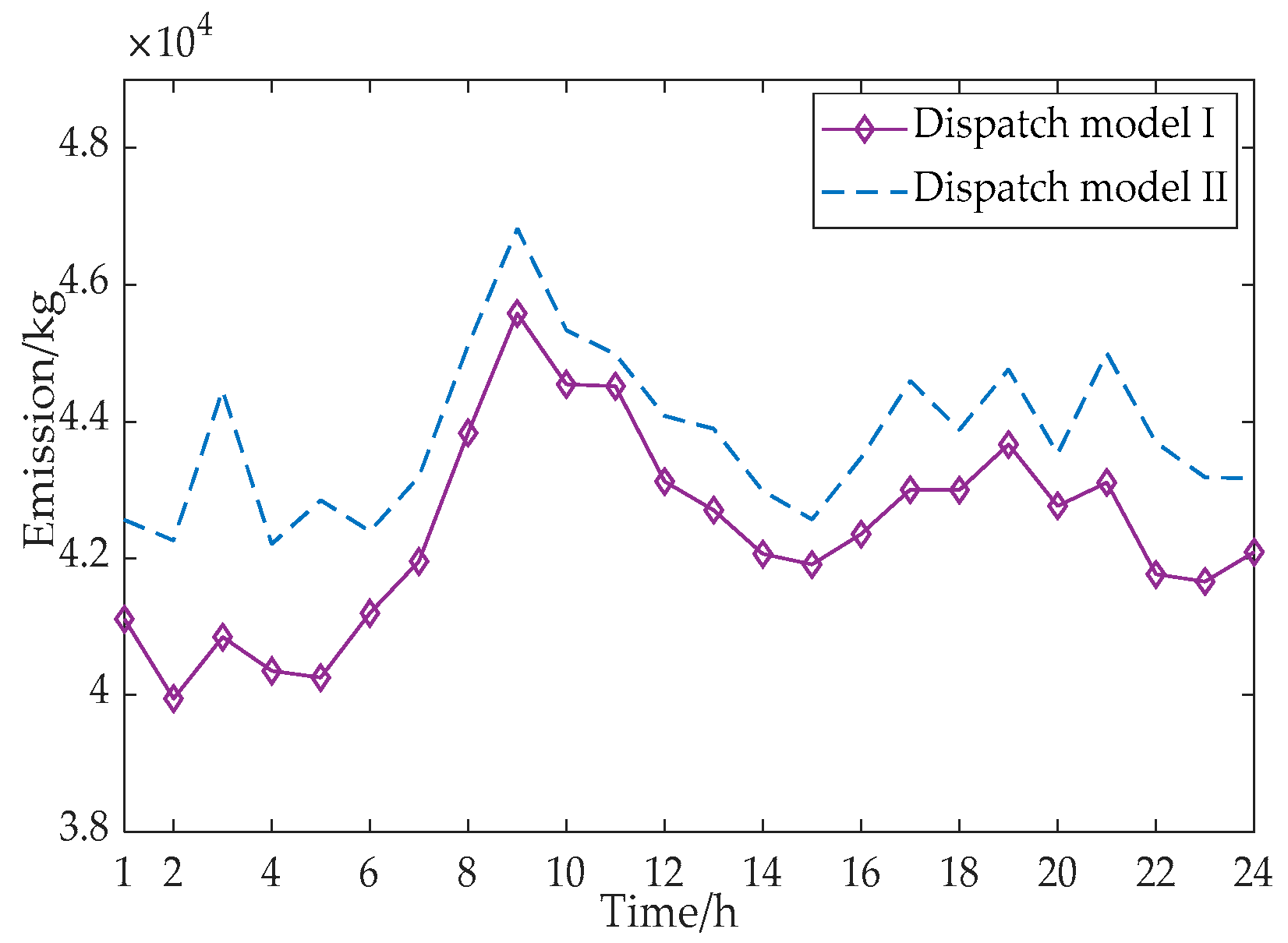
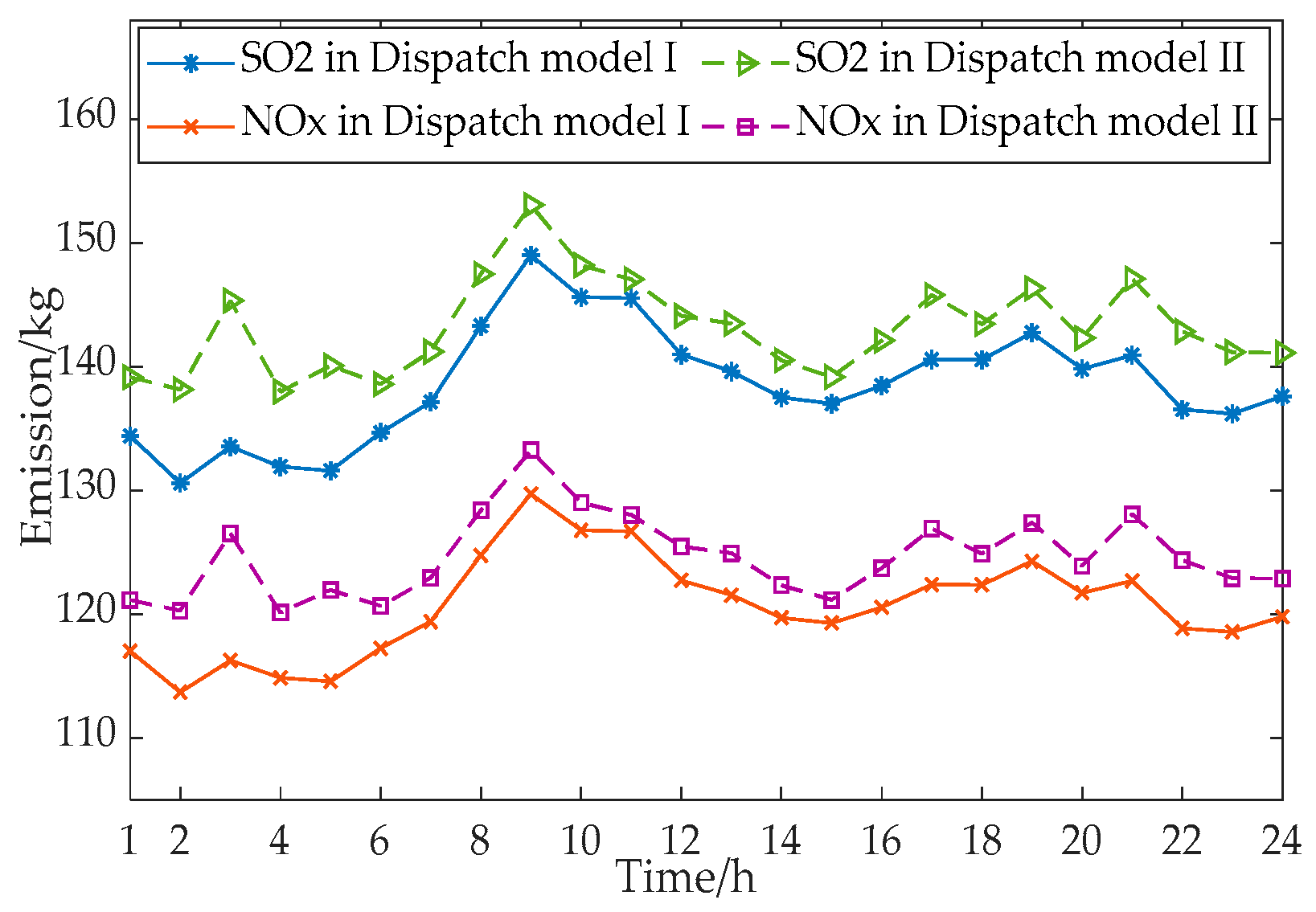
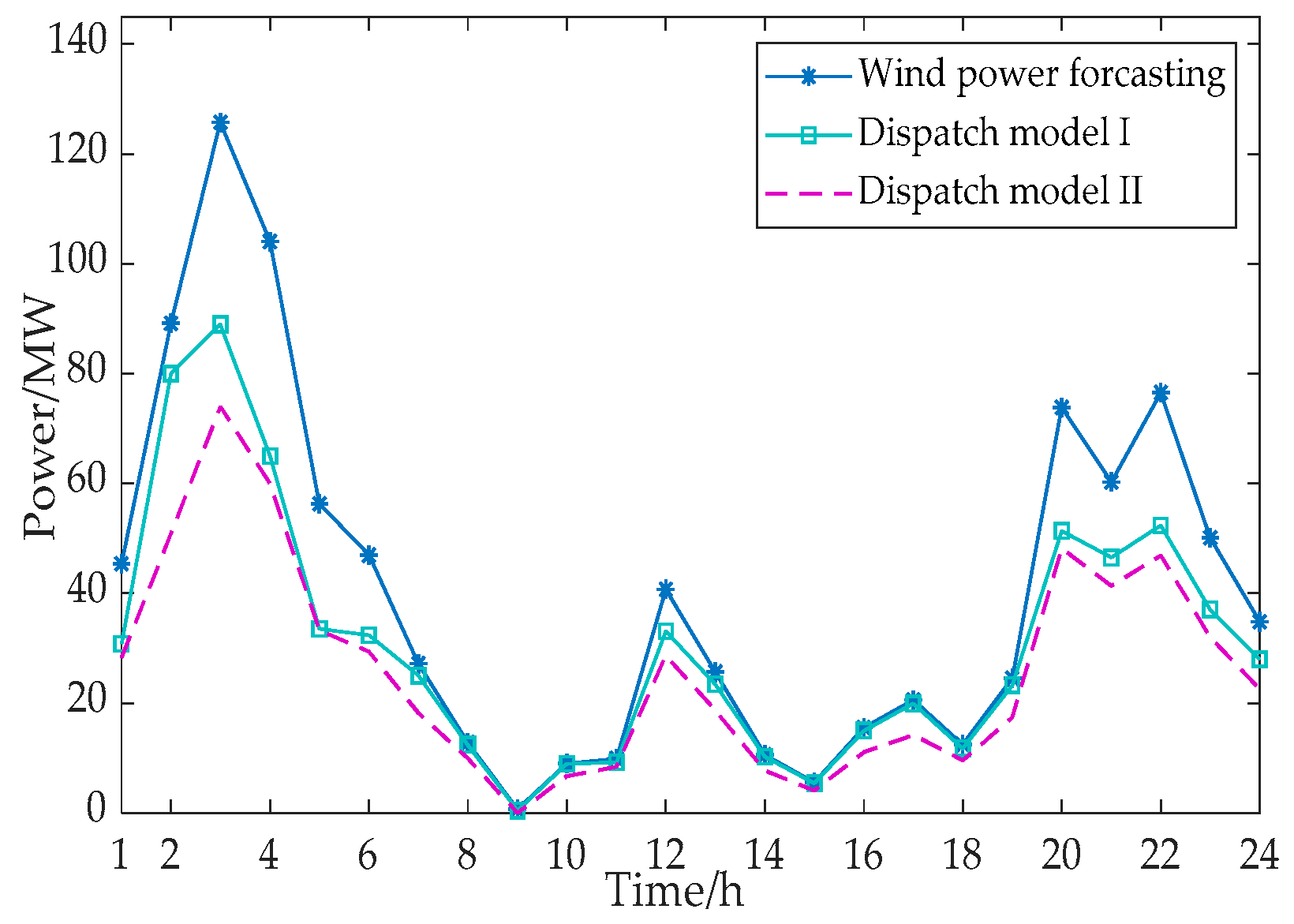
| Parameter | Value | Parameter | Value | Parameter | Value | Parameter | Value |
|---|---|---|---|---|---|---|---|
| am(USD/MW2) | 0.0044 | bi(USD/MW) | 23.66 | CTE(USD/MWh) | 4000 | ρ(USD/MW) | 150 |
| bm(USD/MW) | 13.29 | ci(USD) | 16.22 | TT,i(year) | 20 | ζLmin | 0.9 |
| cm(USD) | 39 | Pmin,i(MW) | 55 | CU(USD/MW) | 10 | ζLmax | 1.1 |
| cv | 0.15 | Pmax,i(MW) | 150 | SOCmin,i | 0.2 | −0.1 | |
| (MW) | 100 | rd,i(MW) | −60 | SOCmax,i | 0.9 | 0.1 | |
| (MW) | 200 | ru,i(MW) | 60 | (MW) | −50 | δC(kg) | 2600 |
| (MW) | 150 | Smin,i(MWH) | 100 | (MW) | 50 | δS(kg) | 8.5 |
| (MW) | 250 | Smax,i(MWH) | 800 | CEP(USD/MW) | 15,000 | δN(kg) | 7.4 |
| (MW) | −50 | (MW) | −100 | CEE(USD/MWh) | 7000 | βm(USD/kg) | 0.6 |
| (MW) | 50 | (MW) | 100 | TE,i(year) | 20 | CQ(USD/MW) | 100 |
| ai(USD/MW2) | 0.03 | CTP(USD/MW) | 8000 | CO(USD/MW) | 26 |
| Day | Emission of CO2 (kg) | Emission of SO2 (kg) | Emission of NOx (kg) | Wind Power Accommodation | ||||
|---|---|---|---|---|---|---|---|---|
| DM I | DM II | DM I | DM II | DM I | DM II | DM I | DM II | |
| 1 | 1,017,394.29 | 1,051,038.37 | 3326.10 | 3436.86 | 2895.66 | 2991.42 | 76.06% | 65.51% |
| 2 | 1,040,712.35 | 1,042,928.91 | 3402.31 | 3451.56 | 2962.72 | 3005.24 | 72.56% | 67.25% |
| 3 | 1,063,664.58 | 1,066,625.36 | 3477.36 | 3504.21 | 3027.35 | 3043.56 | 77.98% | 72.36% |
| 4 | 1,024,336.73 | 1,029,335.86 | 3348.79 | 3365.20 | 2915.41 | 2929.70 | 71.46% | 63.59% |
| 5 | 1,036,482.57 | 1,084,466.21 | 3388.50 | 3545.37 | 2949.99 | 3086.56 | 79.46% | 73.42% |
| 6 | 1,073,234.91 | 1,077,280.69 | 3508.65 | 3521.88 | 3054.59 | 3066.11 | 84.32% | 80.44% |
| 7 | 1,048,089.14 | 1,052,719.62 | 3426.45 | 3441.58 | 2983.02 | 2996.20 | 75.35% | 68.70% |
| Average | 1,043,416.37 | 1,057,770.72 | 3411.17 | 3466.67 | 2969.82 | 3016.97 | 76.74% | 70.18% |
| Model | Fuel Cost (kUSD) | Cost of TES (kUSD) | Cost of EES (kUSD) | Cost of DR (kUSD) | Cost of Wind Curtailment (kUSD) | Environmental Cost (kUSD) | Total Dispatching Cost (kUSD) |
|---|---|---|---|---|---|---|---|
| I | 110.87 | 4.02 | 21.02 | 52.14 | 1.02 | 46.87 | 235.94 |
| II | 118.90 | 3.98 | 23.97 | 43.07 | 1.84 | - | 191.76 |
© 2019 by the authors. Licensee MDPI, Basel, Switzerland. This article is an open access article distributed under the terms and conditions of the Creative Commons Attribution (CC BY) license (http://creativecommons.org/licenses/by/4.0/).
Share and Cite
Li, W.; Li, T.; Wang, H.; Dong, J.; Li, Y.; Cui, D.; Ge, W.; Yang, J.; Onyeka Okoye, M. Optimal Dispatch Model Considering Environmental Cost Based on Combined Heat and Power with Thermal Energy Storage and Demand Response. Energies 2019, 12, 817. https://doi.org/10.3390/en12050817
Li W, Li T, Wang H, Dong J, Li Y, Cui D, Ge W, Yang J, Onyeka Okoye M. Optimal Dispatch Model Considering Environmental Cost Based on Combined Heat and Power with Thermal Energy Storage and Demand Response. Energies. 2019; 12(5):817. https://doi.org/10.3390/en12050817
Chicago/Turabian StyleLi, Weidong, Tie Li, Haixin Wang, Jian Dong, Yunlu Li, Dai Cui, Weichun Ge, Junyou Yang, and Martin Onyeka Okoye. 2019. "Optimal Dispatch Model Considering Environmental Cost Based on Combined Heat and Power with Thermal Energy Storage and Demand Response" Energies 12, no. 5: 817. https://doi.org/10.3390/en12050817
APA StyleLi, W., Li, T., Wang, H., Dong, J., Li, Y., Cui, D., Ge, W., Yang, J., & Onyeka Okoye, M. (2019). Optimal Dispatch Model Considering Environmental Cost Based on Combined Heat and Power with Thermal Energy Storage and Demand Response. Energies, 12(5), 817. https://doi.org/10.3390/en12050817






